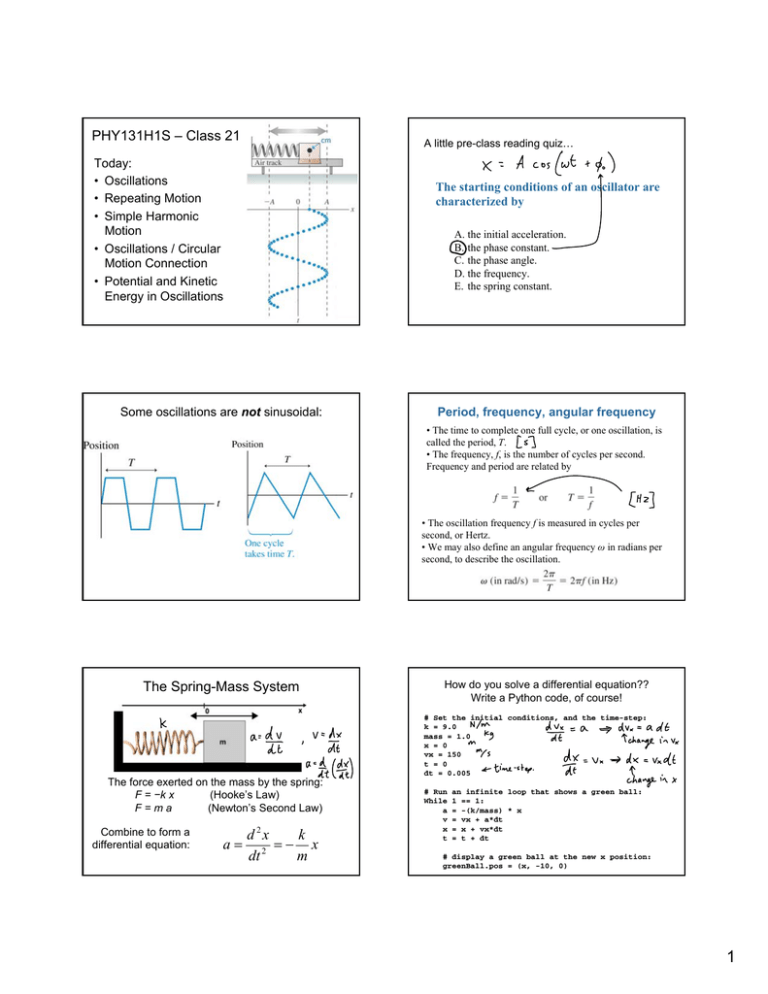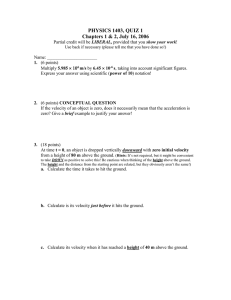Slides
advertisement

PHY131H1S – Class 21 A little pre-class reading quiz… Today: • Oscillations • Repeating Motion • Simple Harmonic Motion • Oscillations / Circular Motion Connection • Potential and Kinetic Energy in Oscillations The starting conditions of an oscillator are characterized by A. the initial acceleration. B. the phase constant. C. the phase angle. D. the frequency. E. the spring constant. Some oscillations are not sinusoidal: Period, frequency, angular frequency • The time to complete one full cycle, or one oscillation, is called the period, T. • The frequency, f, is the number of cycles per second. Frequency and period are related by • The oscillation frequency f is measured in cycles per second, or Hertz. • We may also define an angular frequency ω in radians per second, to describe the oscillation. The Spring-Mass System The force exerted on the mass by the spring: F = −k x (Hooke’s Law) F=ma (Newton’s Second Law) Combine to form a differential equation: a= d 2x k =− x 2 dt m How do you solve a differential equation?? Write a Python code, of course! # Set the initial conditions, and the time-step: k = 9.0 mass = 1.0 x = 0 vx = 150 t = 0 dt = 0.005 # Run While a v x t an infinite loop that shows a green ball: 1 == 1: = -(k/mass) * x = vx + a*dt = x + vx*dt = t + dt # display a green ball at the new x position: greenBall.pos = (x, -10, 0) 1 x Results of the Python code: t This is the position graph of a mass on a spring. What can you say about the velocity and the force at the instant indicated by the dotted line? A. Velocity is positive; force is zero. B. Velocity is negative; force is zero. C. Velocity is negative; force is to the right. D. Velocity is zero; force is to the right. E. Velocity is zero; force is to the left. Simple Harmonic Motion If the initial position of an object in SHM is not A, then we may still use the cosine function, with a phase constant measured in radians. In this case, the two primary kinematic equations of SHM are: This is the position graph of a mass on a spring. What can you say about the velocity and the force at the instant indicated by the dotted line? A. Velocity is positive; force is zero. B. Velocity is negative; force is zero. C. Velocity is negative; force is to the right. D. Velocity is zero; force is to the right. E. Velocity is zero; force is to the left. • A. B. C. D. E. An object moves with simple harmonic motion. If the amplitude and the period are both increased by a factor of 2, the object’s maximum speed is decreased by factor of ¼. decreased by factor of ½. increased by factor of 4. increased by factor of 2. unchanged. 2 EXAMPLE: Using the initial conditions QUESTION: equilibrium A little parting challenge-quiz… Gravitational Potential Energy increases with height. Elastic Potential Energy increases as a spring is stretched. Kinetic Energy increases with speed. A mass hangs motionless from a spring. When the mass is pulled down and held at rest, the total energy of the mass and spring is A. larger than before. B. the same as before. C. less than before. 3

